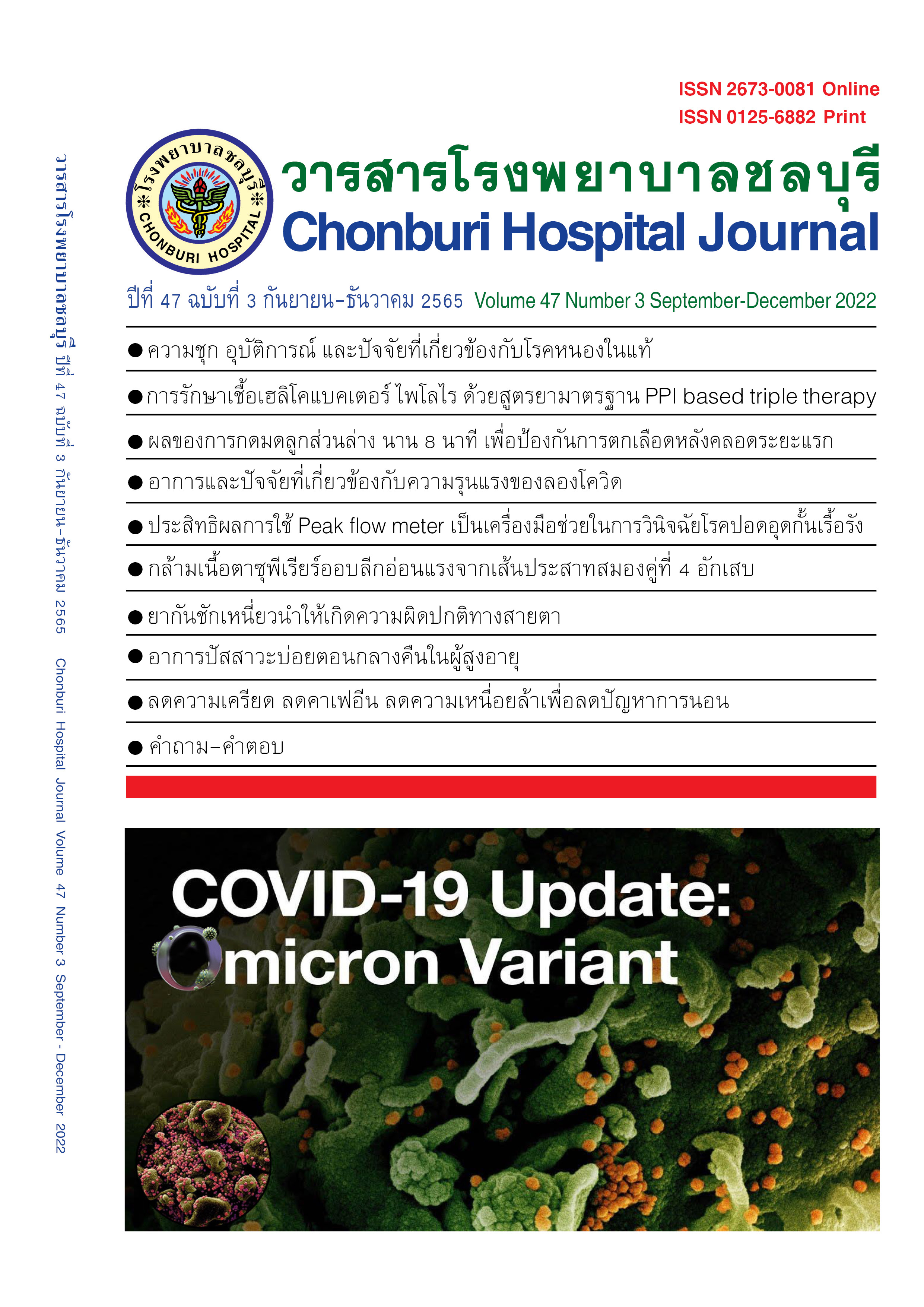The Peak flow meter with a Questionnaire and Plain Chest Radiography as Diagnostic Tools to detect COPD in Real-life Clinical Practice: A Diagnostic Study
Abstract
Introduction: Correct diagnosis of COPD is important to the treatment. According to the diagnostic criteria for COPD, spirometry test results are required. In Thailand, there are limitations in spirometry because this test cannot be performed in every hospital. However, a peak expiratory flow rate (PEFR) from a peak flow meter is easier and can be performed in every hospital. The objective of this research was to study the effectiveness of peak flow meter with questionnaires and plain chest radiographs as diagnostic tools to detect COPD in real-life clinical practice.
Materials and Methods: The research was a cross sectional analytical study in which all subjects were assessed by questionnaires and were measured PEFR, spirometry, and plain chest radiographs were obtained.
Results: A total of 196 patients were enrolled, 141 patients completed the study. Thirty-nine patients (27.66%) were diagnosed with chronic obstructive pulmonary disease (COPD), 100 (70.93%) with asthma and 2 (1.42%) with bronchiectasis. History of dyspnea (mMRC dyspnea scale ≥1), coughing, or chronic sputum production for at least six months had 100% sensitivity, 3.9% specificity, 28.5% positive predictive value, 100% negative predictive value. PEER <80% predicted had 97.4% sensitivity, 53.9% specificity, 44.7% positive predictive value, 98.2% negative predictive value. Normal plain chest radiographs or with hyperaeration had 69.2% sensitivity, 5.9% specificity, 22.0% positive predictive value, 33.3% negative predictive value in the diagnosis of COPD. Area under the receiver operating characteristic curve (AUC) in the diagnosis of COPD was 96.67% (94.07 – 99.27) when predicted by age, gender, history of dyspnea, coughing, or chronic sputum production for at least 6 months, age of onset ≥40 years, history of smoking, frequent exposure to air pollutions, previous history of pulmonary tuberculosis, PEFR <80% predicted and normal plain chest radiographs or with hyperaeration.
Conclusions: Using data from questionnaires and PEFR <80% predicted and normal plain chest radiographs or with hyperaeration were effective diagnostic tools to detect COPD
References
World Health Organization. World Health Report [Internet]. Geneva: WHO; 2000 [cited 2018 Jan 23]. Available from: http://www.who.int/whr/2000/en/statistics.htm
National Health Security Office. Report of asthma and COPD project outcomes in 2012. [cited 2018 Jan 23]. Available from: http://www.nhso.go.th/frontend/NewsInformation Detail.aspr?newsld=Njgy
Global Initiative for Chronic Obstructive Lung Disease. Global strategy for the diagnosis, management, and prevention of chronic obstructive pulmonary disease (2018 report). n.p.: Global Initiative for Chronic Obstructive Lung Disease; 2018.
Tiyaworanan K. Spirometry test results and factors associated with quality of spirometry test in patients with chronic obstructive pulmonary disease (COPD) at Sisaket hospital. Srinagarind Med J 2016;31(6):348-54.
Sichletidis L, Spyratos D, Papaioannou M, Chloros D, Tsiotsios A, Tsagaraki V, et al. A combination of the IPAG questionnaire and PiKo-6® flow meter is a valuable screening tool for COPD in the primary care setting. Prim Care Respir J 2011;20(2):184-9.
Fritha P, Crockettb A, Beilbyc J, Marshalld D, Attewelle R, Ratnanesanf A, et al. Simplified COPD screening: validation of the PiKo-6® in primary care. Prim Care Respir J 2011;20(2):190-8.
Ching SM, Pang YK, Price D, Cheong AT, Lee PY, Irmi I, et al. Detection of airflow limitation using a handheld spirometer in a primary care setting. Respirology 2014;19:689–93.
Kobayashi S, Hanagama M, Yanai M. Early detection of chronic obstructive pulmonary disease in primary care. Intern Med 2017;56:3153-8.
Thorn J, Tilling B, Lisspers K, Jorgensen L, Stenling A, Stratelis G. Improved prediction of COPD in at-risk patients using lung function pre-screening in primary care: a real-life study and cost-effectiveness analysis. Prim Care Respir J 2012;21(2):159-66.
Kjeldgaard P, Lykkegaard J, Spillemose H, Ulrik CS. Multicenter study of the COPD-6 screening device: feasible for early detection of chronic obstructive pulmonary disease in primary care? Int J Chron Obstruct Pulmon Dis 2017;12:2323-31.
Jackson H, Hubbard R. Detecting chronic obstructive pulmonary disease using peak flow rate: cross sectional survey. Br Med J 2003;327:653-4.
Thorat YT, Salvi SS, Kodgule RR. Peak flow meter with a questionnaire and mini-spirometer to help detect asthma and COPD in real-life clinical practice: a cross sectional study. NPJ Prim Care Respir Med 2017;27(1):32. doi: 10.1038/s41533-017-0036-8.
Price DB, Tinkelman DG, Halbert RJ, Nordyke RJ, Isonaka S, Nonikov D, et al. Symptom-based questionnaire for identifying COPD in smokers. Respiration 2006;73:285-95.
Price DB, Tinkelman DG, Nordyke RJ, Isonaka S, Halbert RJ; for the COPD
Questionnaire Study Group. Scoring system and clinical application of COPD
Diagnostic Questionnaires. Chest 2006;129:1531-9.
Dejsomritrutai W, Nana A, Maranetra KN, Chuaychoo B, Maneechotesuwan K, Wongsurakiat P, et al. Reference spirometric values for healthy lifetime nonsmokers in Thailand. J Med Assoc Thai 2000;83(5):457-66.
Miller MR, Hankinson J, Brusasco V, Brugos F, Casaburi R, Coates A, et al. Standardisation of spirometry. Eur Respir J 2005;26(2):319-38. doi: 10.1183/09031936.05.00034805
Downloads
Published
Versions
- 2023-01-05 (2)
- 2022-12-28 (1)
Issue
Section
License

This work is licensed under a Creative Commons Attribution-NonCommercial-NoDerivatives 4.0 International License.
บทความที่ได้รับการตีพิมพิ์เป็นลิขสิทธิ์ของวารสารโรงพยาบาลชลบุรี
